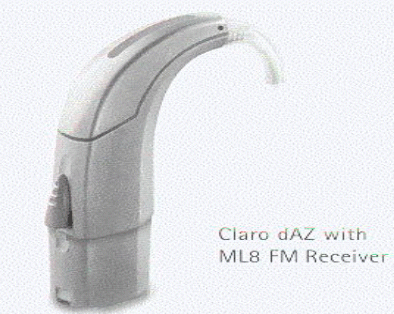Individuals with sensorineural hearing loss (SNHL) often exhibit difficulty understanding speech, particularly in noise (Dubno, Dirks & Morgan, 1984; Suter, 1985; Helfer & Wilber, 1990; Crandell, 1991; Helfer & Huntley, 1991; Killion, 1997). Unfortunately, traditional amplification strategies may provide little or no improvement in adverse listening environments. To date, however, there are several noise reduction technologies that have been shown to improve speech intelligibility (Crandell and Smaldino, 2000). These technologies include directional microphones and personal frequency modulation (FM) systems (Hawkins, 1984; Fabry, 1994; Valente, Fabry, & Potts, 1995; Kuk, Kollofski, Brown, Melum & Rosenthal, 1999; Preves, Sammeth & Wynne, 1999; Pumford, Seewald, Scollie, & Jenstad, 2000; Ricketts, 2000; Valente, Schuchman, Potts, & Beck, 2000).
Directional microphones typically use a cardiod polar plot sensitivity pattern. That is, they reduce signals originating from the rear and the sides and only amplify signals arriving from the front - where the speaker will often be located. For discussions on other polar plot sensitivity patterns the reader is directed to Valente et al. (2000). Numerous investigations have demonstrated that directional microphone technology can enhance speech intelligibility in noisy listening environments (Valente et al., 1995; Gravel, Fausel, Liskow, & Chobot, 1999; Kuk et al., 1999; Preves et al., 1999; Ricketts & Dhar, 1999; Pumford et al., 2000; Ricketts, 2000; Valente et al., 2000; Ricketts et al., 2001). In fact, recent investigations have demonstrated that the utilization of directional microphone technology can improve speech intelligibility in noise by as much as 6 to 8 dB as compared to typical omnidirectional microphone technology (Valente et al., 1995; Gravel et al., 1999; Ricketts & Dhar, 1999; Pumford et al., 2000; Valente et al., 2000). It should be noted, however, that benefits in signal-to noise ratio (SNR) might decrease significantly in reverberant listening conditions.
Personal FM systems have also been shown to improve speech intelligibility in noise (Hawkins, 1984; Fabry, 1994; Crandell & Smaldino, 2000). Past investigations have demonstrated that the utilization of FM technology can improve speech intelligibility in noise by as much as 20-25 dB (see Crandell and Smaldino, 2000). With a personal FM system, the speaker's voice is picked-up via FM wireless microphone located near the speaker's mouth - where the effects of reverberation, distance, and noise are minimal. The FM system converts the acoustic signal to an electrical waveform at the microphone, and the signal is transmitted via FM signal, from the transmitter to the receiver. Both the transmitter and the receiver are tuned to the same transmitting and receiving frequency. At the receiver end, the electrical signal is amplified, converted back to an acoustical waveform and conveyed to the listener.
A recent and popular method for coupling FM systems to the listener with hearing impairment is through an "audio boot" coupled to a BTE hearing aid. This type of technology, such as the Phonak Microlink (see Figure 1), allows the user to convert his/her personal hearing aid into a FM system simply by attaching the audio boot. Typically, such FM systems enable the user to have three FM settings: (1) FM only; for the purpose of focusing primarily on the talker, (2) environmental microphone (EM) only; for the purpose of listening to all individuals in the immediate listening environment as well as monitoring his/her own voice, and (3) FM + EM for listening to both the speaker as well as other individuals in that listening environment.
Despite the documented enhancement in speech intelligibility with directional microphone and FM technologies, only one investigation has attempted to directly compare these two (Hawkins, 1984). In this study, Hawkins (1984) evaluated the speech intelligibility of children utilizing these two types of technologies. Results demonstrated that FM technology, when utilized in the FM only mode, provided significantly better speech recognition in noise when compared to directional microphone technology.
We (the authors of this article) recently began an investigation to examine the speech-perception ability of adults with slight to severe SNHL, in a noisy background, utilizing directional microphone and FM technology. Specifically, speech perception was assessed with the Hearing in Noise Test (HINT) (Nilsson, Soli & Sullivan, 1994). Speech spectrum noise was utilized as the noise source, in the following listening conditions: (1) binaural BTE hearing aids in omnidirectional mode; (2) binaural BTE hearing aids in the directional mode; and (3) binaural BTE hearing aids utilized with two FM receivers in the FM only mode. The speech spectrum noise was presented from four loudspeakers positioned at 45°, 135°, 225°, and 315° azimuths. All loudspeakers were located one meter from the subject and the noise was held constant at 65 dB(A).
Forty-six subjects (recruited from the University of Florida and the Washington University School of Medicine) were evaluated in this study. Subjects ranged in age from 24 to 84 years, with a median age of 73 years. All subjects were fit with Phonak Claro 311 dAZ digital, BTE hearing aids bilaterally. The Phonak Microlink ML8 was used as the FM receiver. All FM receivers were evaluated in the FM only mode. All subjects used the Phonak TX3 HandyMic FM transmitter.
These devices were fit via the Desired Sensation Level (DSL) prescriptive fitting formula on the Phonak Fitting Guideline (PFG) Version 7.3 software. All hearing aid fittings were verified via probe-microphone measures.
Preliminary data from this investigation indicated the following results:
- The mean reception threshold for sentences (RTS) for the directional microphone condition (-0.54 dB) yielded significantly better performance than the omnidirectional microphone condition (2.9 dB). That is, on average, the directional microphones improved the RTS by 3.44 dB.
- The mean RTS for the condition with two FM receivers in the FM only mode (-19.84 dB) yielded significantly better scores than the directional microphone condition (-0.54 dB). Stated otherwise, the binaural FM improved the RTS by 19.3 dB.
Unfortunately, it appears that the vast majority of hearing aid fitting do not include a recommendation of FM technology (Crandell& Smaldino, 2000). We are in the process of completing this investigation and examining other FM listening conditions, such as FM+EM. The authors are also developing counseling programs to assist audiologist in dispensing FM systems to individuals with hearing impairment. For more information on Phonak hearing aids and FM systems, refer to www.phonak.com.

Figure 1: Photograph of the Phonak Claro 311 dAZ BTE hearing aid and Phonak Microlink ML8 Receiver
REFERENCES
Crandell, C. (1991). Individual Differences in Speech Recognition Ability: Implications for Hearing Aid Selection. Ear & Hearing, 5, 100-107.
Crandell, C. & Smaldino, J. (2000). Room Acoustics and Amplification. In Valente, M., Roeser, R., & Hosford-Dunn, H. (Eds.), Audiology: Treatment Strategies, New York: Thieme.
Dubno, J., Dirks, D. & Morgan, D. (1984), Effects of Age and Mild Hearing Loss on Speech Recognition in Noise. Journal of the Acoustical Society of America, 76(1), 87-96.
Duquesnoy, A., & Plomp, R. (1983). The Effect of a Hearing Aid on the Speech-Reception Threshold of Hearing-Impaired Listeners in Quiet and in Noise. Journal of the Acoustical Society of America, 73(6), 2166-2173.
Fabry, D. (1994). Noise Reduction with FM Systems in FM/EM Mode. Ear & Hearing, 15, 82-86.
Gravel, J., Fausel, N., Liskow, C. & Chobot, J. (1999). Children's Speech Recognition in Noise Using Omni-Directional and Dual-Microphone Hearing Aid Technology. Ear & Hearing, 20, 1-11.
Hawkins, D. (1984). Comparisons of Speech Recognition in Noise by Mildly-to Moderately Hearing-Impaired Children using Hearing Aids and FM Systems. Journal of Speech and Hearing Disorders, 49, 409-418.
Helfer, K. & Wilber, L. (1990). Hearing Loss, Aging, and Speech Perception in Reverberation and Noise. Journal of Speech and Hearing Research, 33, 149-155.
Helfer, K. & Huntley, R. (1991). Aging and Consonant Errors In Reverberation and Noise. Journal of the Acoustical Society of America, 90(4), 1786-1796.
Killion, M. (1997). SNR Loss: "I can hear what people say but I can't understand them". The Hearing Review, 4(12), 8-14.
Nilsson, M., McCaw, V. & Soli, S. (1996). Minimum Speech Test Battery for Adult Cochlear Implant Users: User Manual. House Ear Institute: Los Angeles, CA.
Nilsson, M., Soli, S. & Sullivan, J. (1994). Development of the Hearing in Noise Test for the Measurement of Speech Reception Thresholds in Quiet and in Noise. Journal of the Acoustical Society of America, 95(2), 1085-1099.
Plomp, R. (1986). A Signal-To-Noise Ratio Model for the Speech-Reception Threshold for the Hearing Impaired. Journal of Speech and Hearing Research, 29, 146-154.
Preves, D., Sammeth, C. & Wynne, M. (1999). Field Trial Evaluations of a Switched Directional/ Omnidirectional In-the-Ear Hearing Instrument. Journal of the American Academy of Audiology, 10, 273-284.
Pumford, J., Seewald, R., Scollie, S., Jenstad, L. (2000). Speech Recognition with In-the-Ear and Behind-the-Ear Dual-Microphone Hearing Instruments. Journal of the American Academy of Audiology, 11, 23-35.
Ricketts, T. (2000). Impact of Noise Source Configuration on Directional Hearing Aid Benefit and Performance. Ear & Hearing, 21, 194-205.
Ricketts, T. & Dhar, S. (1999). Comparison of Performance Across Three Directional Hearing Aids. Journal of the American Academy of Audiology, 10, 180-189.
Ricketts, T., Lindey, G. & Henry, P. (2001). Impact of Compression and Hearing Aid Style on Directional Hearing Aid Benefit and Performance. Ear & Hearing, 22, 348-361.
Suter, A. (1985). Speech Recognition in Noise by Individuals with Mild Hearing Impairments. Journal of the Acoustical Society of America, 78(3), 887-900.
Valente, M., Fabry, D. & Potts, L. (1995). Recognition of Speech in Noise with Hearing Aids Using Dual Microphones. Journal of the American Academy of Audiology, 6(6), 440-450.
Valente, M., Schuchman, G., Potts, L. & Beck, L. (2000). Performance of Dual-Microphone In-the-Ear Hearing Aids. Journal of the American Academy of Audiology, 11, 181-189.
For more information on Phonak click here.
Click here to visit the Phonak website.


